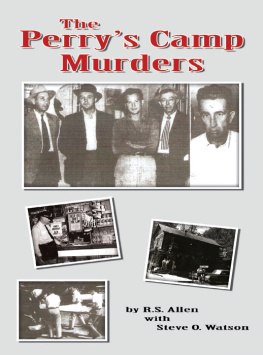O - Spatial simulation. Perry, And George L.W. Perry: exploring pattern and process
Here you can read online O - Spatial simulation. Perry, And George L.W. Perry: exploring pattern and process full text of the book (entire story) in english for free. Download pdf and epub, get meaning, cover and reviews about this ebook. City: Chichester;West Sus, year: 2013, publisher: Wiley Blackwell, genre: Politics. Description of the work, (preface) as well as reviews are available. Best literature library LitArk.com created for fans of good reading and offers a wide selection of genres:
Romance novel
Science fiction
Adventure
Detective
Science
History
Home and family
Prose
Art
Politics
Computer
Non-fiction
Religion
Business
Children
Humor
Choose a favorite category and find really read worthwhile books. Enjoy immersion in the world of imagination, feel the emotions of the characters or learn something new for yourself, make an fascinating discovery.
- Book:Spatial simulation. Perry, And George L.W. Perry: exploring pattern and process
- Author:
- Publisher:Wiley Blackwell
- Genre:
- Year:2013
- City:Chichester;West Sus
- Rating:4 / 5
- Favourites:Add to favourites
- Your mark:
- 80
- 1
- 2
- 3
- 4
- 5
Spatial simulation. Perry, And George L.W. Perry: exploring pattern and process: summary, description and annotation
We offer to read an annotation, description, summary or preface (depends on what the author of the book "Spatial simulation. Perry, And George L.W. Perry: exploring pattern and process" wrote himself). If you haven't found the necessary information about the book — write in the comments, we will try to find it.
O: author's other books
Who wrote Spatial simulation. Perry, And George L.W. Perry: exploring pattern and process? Find out the surname, the name of the author of the book and a list of all author's works by series.
Spatial simulation. Perry, And George L.W. Perry: exploring pattern and process — read online for free the complete book (whole text) full work
Below is the text of the book, divided by pages. System saving the place of the last page read, allows you to conveniently read the book "Spatial simulation. Perry, And George L.W. Perry: exploring pattern and process" online for free, without having to search again every time where you left off. Put a bookmark, and you can go to the page where you finished reading at any time.
Font size:
Interval:
Bookmark:


This edition first published 2013 2013 by John Wiley & Sons, Ltd
Registered office:
John Wiley & Sons, Ltd, The Atrium, Southern Gate, Chichester, West Sussex, PO19 8SQ, UK
Editorial offices:
9600 Garsington Road, Oxford, OX4 2DQ, UK
The Atrium, Southern Gate, Chichester, West Sussex, PO19 8SQ, UK
111 River Street, Hoboken, NJ 07030-5774, USA
For details of our global editorial offices, for customer services and for information about how to apply for permission to reuse the copyright material in this book please see our website at www.wiley.com/wiley-blackwell.
The right of the author to be identified as the author of this work has been asserted in accordance with the UK Copyright, Designs and Patents Act 1988.
All rights reserved. No part of this publication may be reproduced, stored in a retrieval system, or transmitted, in any form or by any means, electronic, mechanical, photocopying, recording or otherwise, except as permitted by the UK Copyright, Designs and Patents Act 1988, without the prior permission of the publisher.
Designations used by companies to distinguish their products are often claimed as trademarks. All brand names and product names used in this book are trade names, service marks, trademarks or registered trademarks of their respective owners. The publisher is not associated with any product or vendor mentioned in this book. This publication is designed to provide accurate and authoritative information in regard to the subject matter covered.
Limit of Liability/Disclaimer of Warranty: While the publisher and author have used their best efforts in preparing this book, they make no representations or warranties with the respect to the accuracy or completeness of the contents of this book and specifically disclaim any implied warranties of merchantability or fitness for a particular purpose. It is sold on the understanding that the publisher is not engaged in rendering professional services and neither the publisher nor the author shall be liable for damages arising herefrom. If professional advice or other expert assistance is required, the services of a competent professional should be sought.
Library of Congress Cataloging-in-Publication Data
O'Sullivan, David, 1966
Spatial simulation : exploring pattern and process / David O'Sullivan, George L.W. Perry.
pages cm
Includes bibliographical references and index.
ISBN 978-1-119-97080-4 (cloth) ISBN 978-1-119-97079-8 (paper)
1. Spatial data infrastructuresMathematical models. 2. Spatial analysis (Statistics) I. Perry, George L. W. II. Title.
QA402.O797 2013
003dc23
2012043887
A catalogue record for this book is available from the British Library.
Wiley also publishes its books in a variety of electronic formats. Some content that appears in print may not be available in electronic books.
Cover image: Photo is of Shinobazu Pond in the Ueno district, Tokyo, April 2012. Photo credit: David O'Sullivan.
Cover design by Nicky Perry.
To
Fintan & Malachy
and
Leo & Ash
Space matters. To answer Douglas Adams' question about life, the universe and everything, we need to detect and understand spatial patterns at different scales: how do they emerge, and how do they change over time? For most spatial patterns in social and environmental systems, controlled experiments on real systems are not a feasible way to develop understanding, so we must use models; but analytical mathematical models that address all relevant scales, entities, and interactions are also rarely feasible.
The advent of fast computers provided a new way to address spatial patterns at multiple scales: it became possible to simulate spatial processes and check whether or not our assumptions about these processes are sufficient to explain the emergence and dynamics of observed patterns. But then, as when any new scientific tool appears, results piled up quickly, perhaps too quickly, produced by thousands of models that were not related in any coherent or systematic way. There is still no general theory of how space matters. Spatial simulation is thus similar to chemistry before the discovery of the periodic table of elements: a plethora of unrelated observations and partial insights, but no big picture or coherent theory.
This book sets out to change the current situation. The authors group spatial simulation models into three broad categories: aggregation and segregation, random walk and mobile entities, and growth and percolation. For each category, they provide systematic overviews of simple, generic models that can be used as building blocks for more complex and specific models. These building blocks demonstrate fundamental spatial processes and principles; they have well-known properties and thus do not need to be justified and analysed from scratch.
Using this book, model developers can identify building blocks appropriate for their own models. They can use the principles of model building and analysis that the book's opening and closing chapters summarize with amazing clarity. The authors demonstrate how all this works in a case study, in which a moderately complex spatial simulation model of island resource exploitation by hunter-gatherers is developed and analysed.
To facilitate the re-use of building blocks, this book itself is based on building blocks, using the free software platforms NetLogo (), which are widely used. All the models and R scripts are available on the internet as a model zoo, or model kit, for the spatial modeller. There (unlike at real zoos) you are invited to play with the zoo's specimens, and even to change and combine them!
This book helps establish a new culture of model building and use by reminding us that, as scientists, we need to see the forest through the trees and, with spatial simulation, the patterns in our explanations of spatial patterns. This book was badly needed. It makes us think, and play.
Volker Grimm,
Helmholtz Centre for Environmental Research UFZ, Leipzig
This book had its genesis in three ideas.
The first, hatched at the 2006 Spatial Information Research Colloquium (or more precisely on the flight back from Dunedin to Auckland), is that for all their seeming variety, there are really only a limited number of truly different spatial processes and models of them. This modest proposal came up in conversation when we realised that we have both become good at anticipating what spatial models will do when they are described at conferences or workshops, and in the research literature. This perhaps debatable insight, followed by extended periods of omphaloscopy (often over a beer), eventually led us to the three broad categories of spatial model (aggregation, movement and spread) whose presentation forms the core of this book. As will become apparent, the dividing lines between these categories are hardly clear. Even so, we think the approach is a valuable one, and we have come to think of these as building-block models. It is a central tenet of this book that understanding these will enable model builders at all levels of experience and expertise to develop simulations with more confidence and based on solid conceptual foundations. Belatedly, we have realised that the building-block model concept has much in common with the notion of design patterns in computer programming and architecture.
The second insight, gleaned from several years' teaching a class where we require students to develop a spatial model on a topic that interests them, is that we (the authors) had picked up a lot of practical and usable knowledge about spatial models over the years, but that that knowledge is not easily accessible in one place (that we know of). This realisation took some time to dawn. It finally did, after the umpteenth occasion when a group of students seeking advice on how to get started with their model were stunned (and sometimes a little grumpy) when the seeming magic of a few lines of code in NetLogo () or R got them a lot further than many hours of head scratching had. Examples
Next pageFont size:
Interval:
Bookmark:
Similar books «Spatial simulation. Perry, And George L.W. Perry: exploring pattern and process»
Look at similar books to Spatial simulation. Perry, And George L.W. Perry: exploring pattern and process. We have selected literature similar in name and meaning in the hope of providing readers with more options to find new, interesting, not yet read works.
Discussion, reviews of the book Spatial simulation. Perry, And George L.W. Perry: exploring pattern and process and just readers' own opinions. Leave your comments, write what you think about the work, its meaning or the main characters. Specify what exactly you liked and what you didn't like, and why you think so.
















